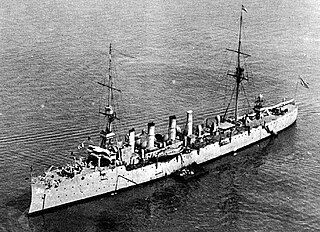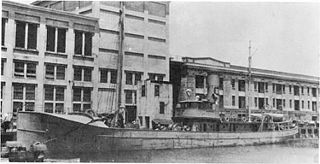
USS Robinson (DD-88) was a Wickes-class destroyer in the United States Navy, later transferred to the Royal Navy, as HMS Newmarket (G47). She was the first ship named for Isaiah Robinson.

USS Stribling (DD-96) was a Wickes-class destroyer in the United States Navy during World War I and the years following. She was the first ship named in honor of Cornelius Stribling.

USS Salem (CS-3/CL-3), Scout Cruiser No. 3, was a Chester-class scout cruiser of the United States Navy. She was the first Navy ship named for the city of Salem, Massachusetts.

USS K-5 (SS-36) was a K-class submarine of the United States Navy. Her keel was laid down by the Fore River Shipbuilding Company in Quincy, Massachusetts, under a subcontract from the Electric Boat Company of Groton, Connecticut. She was launched on 17 March 1914 sponsored by Mrs. Warren G. Child, and commissioned on 22 August.

USS Wilkes (DD-67) was a Sampson-class destroyer in the United States Navy during World War I. She was the second Navy ship named for Commodore Charles Wilkes (1798–1877). She served with the United States Coast Guard as (CG-25).

USS Leonidas (AD-7) was a destroyer tender, the lone ship in her class, named for Leonidas I, and the second United States naval vessel to bear the name.

The auxiliary patrol vessel USS Yacona (SP-617) was built in 1898 in Scotland as a civilian steam yacht of the same name. Later, she was renamed Amélia as a survey yacht of the King of Portugal, before reverting to Yacona in 1901. She was acquired by the U.S. Navy in September 1917 and served until 1919 as a patrol vessel in the western Atlantic. In 1921 she was transferred to the Philippines as the governmental yacht Apo, serving until 1932.

USS Wadena (SP-158) was a converted yacht patrol vessel of the United States Navy during World War I. She was built in 1891 in Cleveland, Ohio, as a steam yacht for Jeptha Homer Wade II of Cleveland and New York City. During her Navy career, Wadena made several trips escorting submarine chasers across the Atlantic Ocean, and, later, patrolling in the Atlantic and Mediterranean. on 26 February 1918 Wadena came to the aid of sinking tug Mariner and rescued all of her crew.
USS SC-255, sometimes styled as either Submarine Chaser No. 255 or S.C.-255, was an SC-1-class submarine chaser built for the United States Navy during World War I. Like most members of her class, she was not named and known only by her designation.
USS SC-142, sometimes styled as either Submarine Chaser No. 142 or S.C.-142, was an SC-1-class submarine chaser built for the United States Navy during World War I. Upon completion, she was transferred to the French Navy
USS SC-277, sometimes styled as either Submarine Chaser No. 277 or S.C.-277, was an SC-1-class submarine chaser built for the United States Navy during World War I. Like most members of her class, she was not named and known only by her designation.
The first USS Barnegat (SP-1232) was a commercial tugboat acquired by the U.S. Navy during World War I. She was armed with a 3-inch gun and sent to Brest, France, to perform towing services for Allied ships. Post-war, she returned to the United States, was decommissioned, and was subsequently used on the Delaware River by the U.S. Army Corps of Engineers.

USS Artemis (SP-593), launched as the steam yacht Cristina then upon sale the yacht was renamed Artemis. The yacht was purchased by the United States Navy during World War I and the name was retained. Artemis was armed with guns and depth charges and sent to Europe as a patrol craft to protect Allied ships from German submarines and other dangers. The patrol yacht was renamed Arcturus in 1918. Post-war she was returned to the United States and turned over to the United States Coast and Geodetic Survey. Later, again Artemis, the vessel was in civilian operation until burning and sinking in 1927.

USS Utowana (SP-951) – also known as USS Victorine (SP-951) -- was a fishing trawler acquired by the U.S. Navy during World War I. The Navy had planned to use her as a minesweeper based out of Kittery, Maine; however, Utowana spent most of her service time operating as an armed patrol craft, responsible for escorting Allied ships across the dangerous North Atlantic Ocean. She served through the war and the armistice before returning to the United States for decommissioning.

The sixth USS Niagara (SP-136), later PY-9, was a United States Navy patrol vessel in commission from 1918 to 1931 and which served during World War I.

The third USS Wanderer (SP-132), was an armed yacht that served in the United States Navy from 1917 to 1919.
USS Wilbert A. Edwards (SP-315), sometimes called USS W. A. Edwards, was a United States Navy patrol vessel in commission from 1917 to 1919.

USS Dreadnaught (ID-1951), later YT-534 and YNG-21, was a United States Navy tug that was in service from 1918 to 1944.

USS Arctic (SP-1158) was a wooden-hulled steam tug acquired by the US Navy during World War I. Arctic was briefly employed as a convoy escort during the war and later used to tow targets and transport ammunition. She was returned to commercial service in 1919.

USS Venetia (SP-431) was a large 589 gross ton steam yacht leased by the U.S. Navy during World War I. She was heavily armed with four 3-inch (76 mm) guns and depth charges, and was assigned duties of a patrol craft, escorting ships in convoy on the North Atlantic Ocean, and protecting those ships from German submarine attack. Venetia was awarded a "star of reward" for her antisubmarine work, and mounted the star on her stack. Post-war she was restored to her original civilian configuration, and was returned to her owner.















